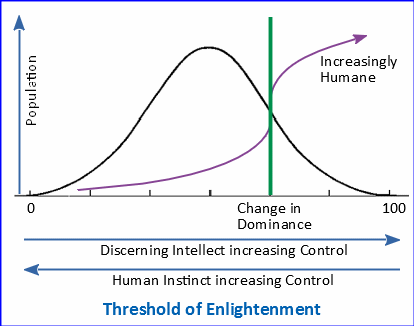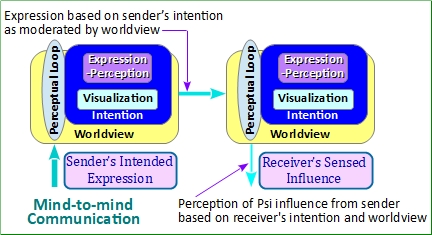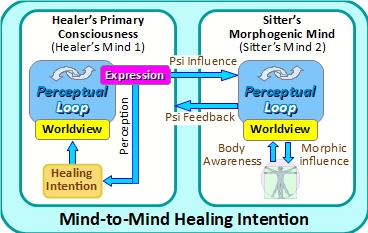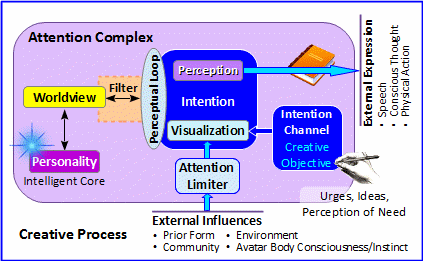Opinion 16
On Being Psychic
Tom Butler, 2023
Brief
This is the compilation of a five-part series of Facebook posts. The objective was to briefly establish the context for questions I have about how to work with healing intention. The parts focus on:
On Being Psychic – 1. Intentionality
I want to make an observation about spiritual healing but first, I think it is important to clarify the dynamics of intentionality as I understand them. I will do so in several posts over the coming days.
A basic function of life is the purposeful formation of expression and perception followed by feedback from the environment leading toward understanding. This feedback also comes from a comparison between what we intend and what we actually experience. I think of this fundamental as the Creative Process.
Expression is an influence that is, in effect, cast into the etheric according to our intention. I like to compare this “sending out our expression” with the way the Internet works. Signals on the internet are composed of digital words that include the address of the device to which they are directed. Everyone on the Internet is connected to everyone else but we only receive that which is addressed to us.
Each of us has a unique address. If you think of our intention directing outward expressions, that intention amounts to an etheric address that everyone can receive. If our intention does not address them, their expression-perception forming process ignores the message.
For all of this to make sense, it helps to remember that the nonlocality of etheric space means we are all here and now. Our separateness is an illusion created by our expression-perception forming processes in what I refer to as our Attention Complex governed by our personal worldview.
We have typically thought of this outward expression of our mind as psychic functioning. More recently, parapsychologists are using the term “Psi” to indicate the expression of thought. For the purpose of ITC, Psi is better thought of as the influence of thought. Expression is always an influence projected into etheric space.
Psi (thought) is nonphysical and does not appear to be directly influenced by the physical. Some parapsychologists refer to the characteristic of the etheric that propagates Psi as the “Psi Field.” The Psi Field is nonlocal, meaning that the influence of Psi is ubiquitous. In effect, everywhere is here in the Psi Field. In effect, we are all one but different aspects of that one.
The takeaway from all of this is that the influence of our thought is everywhere in the world all at once. The factor that goes toward determining how that influence manifests in the world is how well we can manage the creative process … and rapport.
I define the creative process as “Changes in reality are expressed via personality’s attention on an imagined outcome with the intention to make it so.” Thinking and physical movement are mostly automatic processes governed by our worldview; however, in some systems of thought we are asked to examine the implications of our expressions which we experience as perception. I think of how that is done as the Seeker’s Way.
The degree to which our imagined outcome is in agreement with the actual nature of reality is sometimes described as lucidity.
Rapport is a term used to indicate the potential to influence other life fields and thought forms. For instance, our Psi influence on other people is a function of how well we can visualize them — know them like or dislike them, depend on them. This does not seem to matter if the target of our attention is incarnate or discarnate.
Think of a person as a node in a network of rapport links that connect everyone we know and are aware of. Some links are strong and we can more easily visualize the person or thing. Some links represent only a passing interest and we are less able to convey our intention.
I understand that this is complex with many factors to understand. This explanation may be in terms unfamiliar to you, but I describe the concepts this way to help show how they are related to who we are. Otherwise, they are increasingly understood concepts in science.
As always, I am open to questions and suggestions.

On Being Psychic – 2. Rapport
A common practice in development circles is to ask the sitters to mentally sense a discarnate loved one for one of the other sitters in the circle. Some sitters in the circle do quite well while others evidence no apparent psychic ability. Research is showing that psychic sensing and mental mediumship appear to be everyone’s natural abilities, so what is the difference between psychic clear sensing (aka lucidity) and psychic blindness? (Consider the “Threshold of Enlightenment” Diagram included here.) Also see About First Sight Theory
Consider first how we navigate the Psi Field. As mentioned in a previous post, I define the Creative Process as “Changes in reality are expressed via personality’s attention on an imagined outcome with the intention to make it so.” This is a nonphysical process acting on nonphysical thought forms that are sometimes expressed as physical things. For instance, it is thought that intercessory prayer is a mind-to-mind influence that is manifest into the intended biological body via the morphogenic mind (aka body mind).
The major functions in the creative process are attention, imagination (aka visualization) and intention. Six of the corollaries in First Sight Theory seem to tell us how to manage these functions:
Integration: Preconscious processes are processed together with Psi in a rapid, holistic, efficient, unconscious manner to format experience and action. Corollary 3
Weighting and Signing: The importance of sensory and extrasensory information is weighted as being more or less important before it is acted upon. Corollary 5
Summation: The content of conscious experience, emotional states and behavioral choices are constituted in a summative way by unconscious thought. Corollary 6
Bidirectionality: In this summative process, the person may turn toward information (signed positively) to include it in the construction of experience, affect or action, or turn away from information (signed negatively) and exclude it. Corollary 7
Switching: A person will be fairly consistent in how information is processed, (but) may switch in how information is weighted, the sign attributed to it, and therefore, whether or not it is included in behavior. This switching will occur rapidly or slowly depending on the consistency and purity (focus) of unconscious intention, and this, in turn, is determined by the relative weight of the information over time, situational factors that promote or diminish critical analysis, changes of approach in a task and mood. Corollary 9
Extremity: The frequency of switching affects the relative density of accumulated additive or subtractive references to the meaning in question. Rapid switching renders potential meaning irrelevant to ongoing experience. Corollary 10
I define the Organizing Principle of Rapport as “Personalities are interconnected by links of cooperation (influence) forming a matrix of relationships (cooperating community).” One personality’s awareness of another personality manifests as a link of influence between the two life fields that is related to attention and intention. The nature of this link of rapport depends on the clarity of awareness (lucidity) and the reason for the awareness (intention). These links are dynamic and are thought to facilitate cooperation.
The point here is that the mind-to-mind connection with other people can be characterized as rapport. The quality of that rapport depends on our worldview and our ability to manage how our mind processes information resulting in outward expression and how we perceive that expression.
Expression comes before perception. Thanks to the influence of cultural contamination and human instincts, expression is not always as intended. Understanding how we develop expression can help us manage how we gain understanding (increasing discernment leading to greater lucidity). This is mainly accomplished by habitually examining the implications of our perception.
Rapport appears to be related to psychic sensing. More lucid rapport is thought to be possible by learning to manage such mental functions as Switching (related to focus) – First Sight Corollary 9, Weighting and Signing (related to intention) – First Sight Corollary 5.

On Being Psychic – 3. Healing Intention
It is understood amongst people who accept that we are spiritual beings having a human experience that it is possible for us to help others with our thoughts.
In the tradition of organized Spiritualism, spiritual energy is thought to be made available by why of the healer’s discarnate helpers. In that system of thought, the healer is just a conduit.
A healing session involves the expression of a practitioner’s (the healer) intention to help a sitter (the person being healed). The healing influence is typically expressed with the intention to directly improve the sitter’s health, or at least to improve the sitter’s general sense of wellbeing.
Some healing techniques involve the practitioner touching or nearly touching the sitter. Examples include laying-on of hands, Reiki, therapeutic touch. An influence on the sitter via noncontact or intercessory prayer has been experimentally demonstrated. This reinforces the idea that the practitioner need not be physically near the sitter.
As in a mediumship development circle mentioned in the section on rapport, some people more effectively express the intention to heal. At the same time, the sitter may be more or less open to the influence.
Sitters typically report some form of “feeling better” benefit. However, healer ability appears to fall on a “bell curve” in that probably any person-to-person attention can be beneficial, but only a small percentage of practitioners have reported apparent cures of major problems. We see a similar effect in physical mediumship.
A challenge for people learning psychic sensing is learning to distinguish between lucid sensing and imagined sensing. Healing practitioners must learn to distinguish between information sensed about the sitter and imagined information dreamed up by the storyteller mind.
The Mind-to-mind Communication Diagram included here illustrates how the influence of the sender’s conscious intention (healing intention in this discussion) is changed by the practitioner’s mental process that produces expression and perception. That process is moderated by the practitioner’s worldview to better agree with what the practitioner thinks is true. That means the mind-to-mind link of the information flow is typically a version of what was intended. Doubt, for instance, is thought to be a major limiting factor.
The sitter’s mind also acts as a moderator for incoming environmental signals. As illustrated in the Creative Process Diagram in the Intentionality section, the sitter’s Attention Limiter might ignore the influence as unbelievable or uninteresting. If accepted, the influence is moderated by the sitter’s worldview to better agree with expectations.
The expected healing influence may be very different from what was intended. That is why it seems more correct for such healing to be thought of as “healing intention” rather than “spiritual healing.” Taking a lead from other practitioner-sitter relationships such as hypnosis and guided meditation, intending the highest good for the sitter is probably the best approach.

Engraving by Camille Flammarion. 1888
On Being Psychic — 4. The Etheric-Physical Interface
In the early days of EVP, the focus was on magnetism to explain the etheric-physical interface. That was probably because all of us were using magnetic tape recorders. Using magnetism to explain the etheric-physical interface pretty much vanished when digital voice recorders came on the scene.
The focus turned to the relationship between sound and EVP. Some EVP researchers were looking at the way speech is formed. They reported that, although the presumed discarnate speaker’s voice sounded the same as it did when the person was still in the flesh, the formants in the EVP examples were sometimes oddly arranged and the F0 formant was typically corrupted. ITC is more a simulation of the intended feature.
We also noted that the frequency range of speech in EVP tends to follow the frequency range of available ambient noise. It was evident that relatively chaotic noise more often produced EVP than more regulated noise such as white or pink noise.
At the same time, parapsychologists were showing that the output of random processes tended to change in randomness when associated with meditating people. The mind can influence the physical in that way.
We knew that EVP could be recorded without using a microphone. That implied that speech formation was in the circuitry and not in the air. Random Event Generators (REG) used in consciousness research and devices used for both audio (EVP) and visual ITC recorders use similar nonlinear semiconductor amplifier stages.
The revelation here is that mind appears to influence the randomness of physical noise. The electronics are only necessary to make the transformed noise audible or visible. A common physical characteristic is that small signals are amplified by way of stochastic resonance enabled in a nonlinear stage of the electronics.
The small signal appears to represent the etheric-physical interface. Presumably, it is formed as the psychokinetic expression from the communicating mind. But how that mental expression-to-physical process works remains a mystery.
My best guess is that the mind acts on the concept thoughtform representing the physical thing. That is consistent with some researcher’s contention that we as nonphysical life forms create the physical with our intention.
An alternative hypothesis is based on Quantum Mechanics (QM). The majority of people I communicate with and much of the popular science literature presents some version of QM to explain consciousness and paranormal phenomena.
Like stochastic resonance, QM principles may be involved on the physical side of the mental influence. However, my best guess is that the etheric is only “QM-like” when considered from the perspective of physicalism. After all, one of Nature’s favored architectures is the nested hierarchy which can look like quantum phenomena. If all is one in reality, then nonlocality seems to require something that looks like entanglement, but which is referred to as rapport in metaphysics.
We lost years of investigation thinking EVP is a magnetic phenomenon. Our forward progress virtually stopped for a time as people flirted with all sorts of “silver bullet” techniques for EVP such as radio-sweep and other ghost box approaches. Some people are still confounding our understanding of visual ITC with obscuring rather than transforming techniques.
From my years of studying these phenomena, QM is shaping up to be another rabbit hole being recommended to us by people insisting on explaining apparent paranormal phenomena with physical principles alone.
The importance of understanding the etheric-physical interface is that how we conduct our life is added to or diminished by the way we relate to our etheric nature. The Seeker’s Way requires a realistic view of that interface. If you are a seeker, learn to self-educate while suspending judgement until your understanding is both decisive and supported by good research.

On Being Psychic – 5. The Healer’s Paradox
The previous “On Being Psychic” posts were intended to provide the context for a question I have about healing intention. I would like your input about what you were taught concerning healing intention and how you have integrated that into your worldview.
The cosmological model I work with has evolved from my effort to understand ITC and how, if at all, contemporary parapsychology might be integrated with lessons learned from ITC. The model is intended to help seekers learn to manage their worldview.
Based on my experience, healing intention (aka spiritual healing) can be modeled as four primary modalities:
- Practitioner touches or nearly touches sitter. For instance, laying on of hands, Reiki, auric healing. In essence, the practitioner’s hands are considered emitters of healing energy. This is supposed to involve “spiritual” energy but may involve the practitioner’s vital energy.
- Practitioner “sends” healing to a sitter. For instance, intercessory prayer and distant projection of healing intention. This may involve asking God or a discarnate personality to help the sitter. Alternatively, this may involve the practitioner’s visualization of the sitter with the intention of “sending” healing based on the practitioner’s intention and without asking for help from presumed discarnate personalities.
- Self-healing. This is typically guided visualization or self-induced trance. The objective is typically to “cure” an ailment such as visualizing white blood cells attacking cancer cells. This is often used to help the sitter-practitioner change mental wellbeing.
- Intention-imbued objects. I have seen this as the practitioner mentally “charging” a glass of water with healing intention and offering it to the sitter to drink like medicine. I have also seen a development circle collectively focus on an object such as a crystal or stuffed animal with the intention of imbuing it with healing intention. The object is then offered to a sitter as a sort of healing talisman.
These healing modalities assume that a Psi expression by one personality is able to influence another personality, either local or nonlocal. The idea that objects can retain intentionality seems better thought of as the object acting as a focus point for intentionality in the sense of rapport. That is, the object may not “hold” the intentionality itself. It is more likely that it acts as a point of focus linking healer with sitter over distance and time.
Consider the Mind-to-mind Healing Intention Diagram offered here. It depicts my best-guess model of the “circuit” for how the healer’s and the sitter’s minds are connected. Notice the similarity between it and the Mind-to-mind Communication Diagram in 3. Healing Intention. The Two Mind Model for a person requires that our etheric self (Mind 1) can only influence our human avatar by way of the mind that is responsible for organizing the biological organism (Mind 2).
It is assumed by most healers that the healing effect will be experienced where it is needed. Over the years, I have experimented with focusing my intentionality on the sitter’s body. Later, I tried focusing on my sitter’s Mind 1, and later still, on the sitter’s Mind 2. Currently, I focus on a mental image of my sitter while imagining the sitter in bright, healing light. Since I try to be spontaneous, it is surprising to me that different sitters tend to show in my mind with different colors.
Also notice the Psi Feedback link in the Healing Intention Diagram. It represents part of a link of rapport that tends to inform the practitioner’s Mind 1 about the sitter’s mental and physical condition. That link may be responsible for giving the practitioner the sense that they are directly feeling the sitter’s energy when in fact, they are psychically sensing the field via the Psi Feedback link. That information then, may be explained by the practitioner’s mental storyteller as a physical sense of touch.
My question is, when I express healing intention as a practitioner, should I be visualizing the sitter’s body, the sitter’s etheric self (Mind 1) or the sitter’s morphogenic self (Mind 2)? What have you been taught?
![]()

